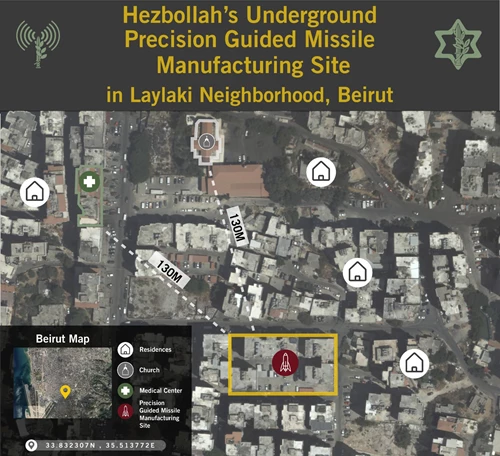On September 29, 2020, the IDF exposed three Hezbollah Precision Guided Missile (PGM) manufacturing sites located in civilian neighborhoods in the heart of the Lebanese capital, Beirut. On October 2, 2020, the IDF published further details about Hezbollah’s activity in the three sites.
The three PGM manufacturing sites in Beirut are all either in or in close proximity to civilian buildings:
An underground PGM manufacturing site in the Laylaki neighborhood: the site is underneath a seven-story residential building, home to over 70 families, and is near a medical center and a church approximately 130 meters from the site.

- An underground PGM manufacturing site located in the Chouaifet neighborhood: the site is underneath a five-story residential building, home to approximately 50 families, and is nearby a mosque, approximately 90 meters north of it.

- A PGM manufacturing site in the industrial area of the Jnah neighborhood: the site is nearby two gas companies, one immediately adjacent and one 50 meters away, and a gas station, which is a few dozen meters away.

The IDF exposed an additional Hezbollah underground site in another civilian neighborhood in Beirut, Borj El Brajneh, on October 2, 2020.
These PGM manufacturing sites, deliberately placed in the heart of populated areas in Beirut, put the lives of Lebanese civilians at risk. The disaster which occurred in the Beirut Port last August and the explosions in September showcase the extent to which the lives, the security, and the property of Lebanese civilians are at risk.

Hezbollah’s strategy to hide weapons and operate from civilian neighborhoods stems from its intentions to draw the IDF to target these civilian areas in times of escalation. If Hezbollah were to target Israeli civilians from these sites, the IDF would have no choice but to react—potentially placing Lebanese civilians in harm’s way—causing international outrage toward the IDF.
On September 29, 2020, hours after the exposure of the three sites, Hezbollah Secretary-General Hassan Nasrallah invited journalists on a press tour of the Jnah neighborhood and claimed that it is a civilian site.
During the tour, journalists documented a series of machines at the Jnah site used for the production of PGMs. These included:
Bending machine: Used to shape the metal of missile engine casings, warheads, and navigation component housings.
Rolling machine: Used to form metal cylinders and used to form engine component, warhead and navigation component casings.
Laser/hydraulic/manual cutting machines: Used to cut metal into needed dimensions and used to create missile stabilization fins, engine casings, and warheads.
The IDF can reveal that Hezbollah operative Muhammad Kamel Fouad Rammal, who operates in Hezbollah’s PGM production unit, is the Jnah PGM production site manager. Hezbollah has presented Rammal as a citizen instead of a member of the terror organization. As part of his role in the organization, he has flown to Iran several times with other operatives.

In addition, the IDF identified suspicious traffic in the Chouaifet neighborhood in the days following the exposure, including a transport van arriving at the site and leaving several hours later. From the site, the van continued to an underground site used by the Hezbollah terrorist organization, located under a civilian residential building in the Borj El Brajneh neighborhood.
What are PGMs?
Precision Guided Missiles are projectiles equipped with highly advanced navigation systems enabling them to strike targets within an accuracy of a few meters.
Why is Hezbollah acquiring PGMs?
Hezbollah has continually threatened to fire rockets at Israel from Lebanon. With Precision Guided Missiles, Hezbollah has the ability to directly target Israeli civilians, towns, and cities.
How is Hezbollah acquiring these PGMs?
After several failed attempts to transfer ready-to-use PGMs between 2013 and 2015, read more here, Iran has been sending Hezbollah PGM parts to assemble in manufacturing and conversion factories in Lebanon.
Is this the only way Hezbollah is using Lebanese civilians as human shields?
No. In addition to placing PGM manufacturing sites in civilian neighborhoods, Hezbollah also places weapon warehouses in civilian areas across Lebanon. These sites have resulted in various explosions in populated areas over the last number of years—due to Hezbollah neglect. Most recently, on September 22, 2020, a weapons warehouse in the village of Ain Qana exploded, endangering Lebanese civilians.
How are these terror sites and explosions impacting Lebanon?
The state of Lebanon is currently suffering a deep national, economic and health-related crisis, worsened by the explosions in the Beirut Port and the series of explosions of Hezbollah warehouses.
What has the IDF done about it?
The State of Israel and the IDF have reported these sites numerous times, both to the UN and to additional diplomatic networks, as well as through various media channels.
In its decision to expose these three sites in Beirut, the IDF hopes to call the Lebanese government out again, with the support of the international community, to intervene in the matter. The IDF hopes to help Lebanese civilians protect themselves from the risks caused by the entrenchment of the Iranian-proxy Hezbollah in their country.
The IDF will continue to extensively operate against these threats through various methods and tools to protect both Israeli and Lebanese civilians.
